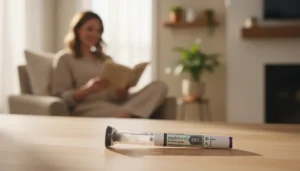Can You Take Half a Dose of Zepbound? Understanding Dosage and Administration

When it comes to managing weight through medication, clarity on dosing is crucial. For those using Zepbound® (tirzepatide), a popular GLP-1 receptor agonist, questions often arise regarding how to administer the drug properly, especially concerning dosage adjustments. One common inquiry is, can you take half a dose of Zepbound? This post delves into the intricacies of Zepbound dosing, the implications of altering prescribed amounts, and how to navigate your weight loss journey effectively.
Introduction
Have you ever found yourself wondering if it’s safe to adjust your dosage of medication? You’re not alone. Many individuals managing weight issues may encounter situations where they question the necessity of sticking rigidly to their prescribed dosage. This is particularly relevant for medications like Zepbound, which are designed to assist in weight management by reducing appetite and promoting feelings of fullness.
Zepbound has gained attention for its effectiveness in helping adults with obesity or weight-related medical issues. However, with its various dosing options and delivery methods, questions about how to properly utilize this medication are common. Understanding the importance of adhering to prescribed dosages, the risks associated with splitting doses, and the best practices for administering Zepbound can empower you on your weight loss journey.
In this blog post, we will explore the following key areas:
- Understanding Zepbound and Its Mechanism: What is Zepbound, and how does it work?
- Dosage Guidelines: What are the recommended dosages for Zepbound?
- The Risks of Splitting Doses: Why is it not advisable to take half a dose?
- Best Practices for Administration: How to use Zepbound safely and effectively.
- Navigating Side Effects and Adjustments: What to do if you experience side effects or need to adjust your regimen.
By the end of this post, we hope to provide you with a comprehensive understanding of Zepbound dosing and administration, empowering you to make informed decisions about your weight management journey.
Understanding Zepbound and Its Mechanism
Zepbound (tirzepatide) is an injectable prescription medication designed to help adults manage obesity and weight-related medical conditions. As a GLP-1 receptor agonist, it works by mimicking the hormones that regulate appetite and glucose levels in the body. This mechanism leads to reduced hunger, increased feelings of fullness, and improved glucose metabolism.
When utilized alongside a reduced-calorie diet and increased physical activity, Zepbound can significantly aid in weight loss. Clinical studies have shown that patients can achieve an average weight loss of around 15% of their body weight with this medication, demonstrating its effectiveness as part of a comprehensive weight management plan.
Dosage Guidelines
Zepbound is available in multiple dosage options, including 2.5 mg, 5 mg, 7.5 mg, 10 mg, 12.5 mg, and 15 mg. The medication is typically administered once weekly, either via a prefilled pen or a single-dose vial, depending on what your healthcare provider prescribes.
Here are the key points to remember regarding Zepbound dosage:
- Starting Dose: Patients usually begin treatment at 2.5 mg once weekly. After four weeks, the dose may be increased to 5 mg, based on individual response and tolerability.
- Maintenance Doses: The recommended maintenance doses are 5 mg, 10 mg, or 15 mg, depending on individual treatment goals and body response.
- Administration Method: Zepbound can be injected subcutaneously in areas such as the abdomen, thigh, or upper arm.
Following your healthcare provider’s guidance on the dosing schedule is essential to achieve optimal results and minimize potential side effects.
The Risks of Splitting Doses
A common question among users is whether they can take half a dose of Zepbound, especially if they have a higher dosage pen available. The straightforward answer is no, and there are several reasons for this recommendation:
-
Single-Dose Vial Design: Zepbound vials and pens are designed for single-use. Splitting doses can lead to contamination, inaccurate dosing, and reduced effectiveness of the medication. The lack of preservatives in these products means that any remaining medication cannot be safely stored for future use.
-
Injection Mechanics: Zepbound pens are designed to deliver a predetermined amount of medication in one action. Attempting to stop or adjust the injection mid-dose is not possible with the standard auto-injector design. Once activated, the injection will complete, delivering the full amount of medication.
-
Lack of Clinical Evidence: There are no established studies or guidelines that support the safety or efficacy of splitting doses. This lack of evidence raises concerns about the potential impact on treatment outcomes and patient safety.
-
Increased Side Effects: Taking a dose that is not aligned with the prescribed amount can increase the risk of adverse effects. Zepbound can cause gastrointestinal side effects, and an improper dose may exacerbate these issues.
Given these factors, it is crucial to adhere to your prescribed dosage and consult with your healthcare provider if you have concerns about your medication.
Best Practices for Administration
To ensure safe and effective use of Zepbound, follow these best practices:
-
Consult Your Healthcare Provider: Always discuss any changes or concerns regarding your medication with your provider. They can help you navigate questions about dosage adjustments or side effects.
-
Use the Medication as Directed: Administer Zepbound exactly as prescribed, following the instructions provided with your medication. This includes understanding the correct injection technique and timing.
-
Store Properly: Zepbound should be stored in the refrigerator between 36°F to 46°F (2°C to 8°C). If you need to use it at room temperature, it can be kept at temperatures up to 86°F (30°C) for up to 21 days. Never return a pen or vial to the refrigerator once it has been kept at room temperature.
-
Rotate Injection Sites: To minimize the risk of injection site reactions, rotate the area where you inject the medication. This practice helps reduce discomfort and skin irritation.
-
Monitor for Side Effects: Be aware of common side effects such as nausea, diarrhea, abdominal pain, and fatigue. If side effects persist or worsen, consult your healthcare provider for guidance.
Navigating Side Effects and Adjustments
Weight loss medications like Zepbound can produce varying side effects, especially when starting treatment or adjusting dosages. Here’s how to manage potential issues:
-
Stay Hydrated: If you experience gastrointestinal side effects, it’s essential to stay hydrated. Drink plenty of fluids to help mitigate dehydration risks associated with nausea, vomiting, or diarrhea.
-
Gradual Dose Adjustments: If your healthcare provider decides to adjust your dosage, it may be done gradually to allow your body to adapt. Sudden changes can lead to intensified side effects.
-
Report Concerns: Always report any side effects or concerns to your healthcare provider. They can help determine whether your symptoms are expected and if any intervention is necessary.
-
Follow Up Regularly: Regular follow-up appointments can help monitor your progress and allow for timely adjustments to your treatment plan.
Conclusion
Understanding the proper administration and dosage of Zepbound is crucial for achieving effective weight management. Taking half a dose of Zepbound or attempting to split the medication is not advisable due to safety, efficacy, and design reasons.
By adhering to the prescribed dosage and administration guidelines, you can maximize the benefits of this medication while minimizing potential risks. If you have any questions or concerns about your treatment plan, we encourage you to reach out to your healthcare provider.
For those seeking personalized support in their weight loss journey, we at TrimRx are dedicated to providing individualized care through clinically proven solutions. Our approach merges cutting-edge telehealth innovations with a commitment to safe and effective weight loss. If you’re interested in exploring our personalized weight loss programs, take our free assessment quiz today to see if you qualify for our prescription weight loss medications.
FAQs
Can you safely take half a dose of Zepbound to reduce side effects?
Taking half a dose of Zepbound is possible under medical supervision. TrimRx helps patients personalize Zepbound dosing to manage tolerance while maintaining consistent fat-loss results.
Does cutting the Zepbound dose in half still provide weight loss benefits?
Yes, though progress may slow slightly. TrimRx tracks patient outcomes to ensure half-dose Zepbound administration remains effective for gradual weight management.
Why might someone take half a dose of Zepbound instead of the full amount?
Patients sensitive to side effects like nausea often start lower. TrimRx adjusts Zepbound doses to balance comfort and efficiency throughout treatment.
Can taking half a Zepbound dose affect blood sugar control?
It might reduce glucose regulation slightly. TrimRx monitors blood sugar stability in patients who take smaller Zepbound doses for safe outcomes.
How do you accurately measure half a dose of injectable Zepbound?
Use precision dosing techniques. TrimRx provides professional instruction for correct half-dose Zepbound injection preparation and administration.
Does taking half a dose make Zepbound side effects milder?
Yes, a smaller dose often minimizes nausea or fatigue. TrimRx starts many patients on conservative Zepbound doses to enhance medication tolerance.
Is it better to take half a Zepbound dose more frequently instead of the full weekly amount?
No, dosing schedules should not be altered without guidance. TrimRx maintains safe weekly Zepbound intervals, even for half-dose treatments.
Can half-dosing Zepbound delay when you see weight loss results?
Yes, weight loss may progress more gradually. TrimRx ensures consistent progress tracking for half-dose Zepbound users.
Are there benefits to staying on a half dose of Zepbound long term?
Yes, some patients maintain results this way. TrimRx determines when ongoing half-dose Zepbound use is ideal for weight stability.
What’s the safest way to transition from a full Zepbound dose to a half dose?
Reduce dosage under professional direction. TrimRx provides personalized tapering schedules to optimize Zepbound therapy transitions safely.
Can splitting a Zepbound pen dose damage the medication?
No, but it must be done carefully to maintain sterile technique.
Is it okay to skip a week after taking a half dose of Zepbound?
Skipping can disrupt hormonal balance—consistency is recommended.
Does insurance cover adjusted or half doses of Zepbound?
Coverage depends on your plan, as compounding or partial prescriptions may differ.
How do I know if a half Zepbound dose is working effectively?
Track weekly weight and hunger levels to confirm consistent fat reduction.
What should I do if half a dose of Zepbound doesn’t seem effective?
Consult your provider before increasing dosage to avoid side effects or inefficiency.

Transforming Lives, One Step at a Time
Keep reading
Navigating Your Path: How Many Doses Are In Zepbound and What It Means for Your Health Journey
Curious how many doses are in Zepbound? Discover its weekly dosing schedule, available strengths, and titration process for effective weight loss. Learn more!
Navigating Your Zepbound Journey: Understanding Dosing and Expert Guidance
Wondering how to split doses of Zepbound? Learn why it’s unsafe & not recommended. Get expert guidance on Zepbound dosing for safe, effective weight loss with TrimRx. Click to learn more!
Understanding Zepbound Dosing: What is the Lowest Dose Available for Your Weight Loss Journey?
Curious what is the lowest dose of Zepbound available? Learn about Zepbound’s 2.5mg starting dose, titration, and safe use for weight loss. Get expert guidance!



